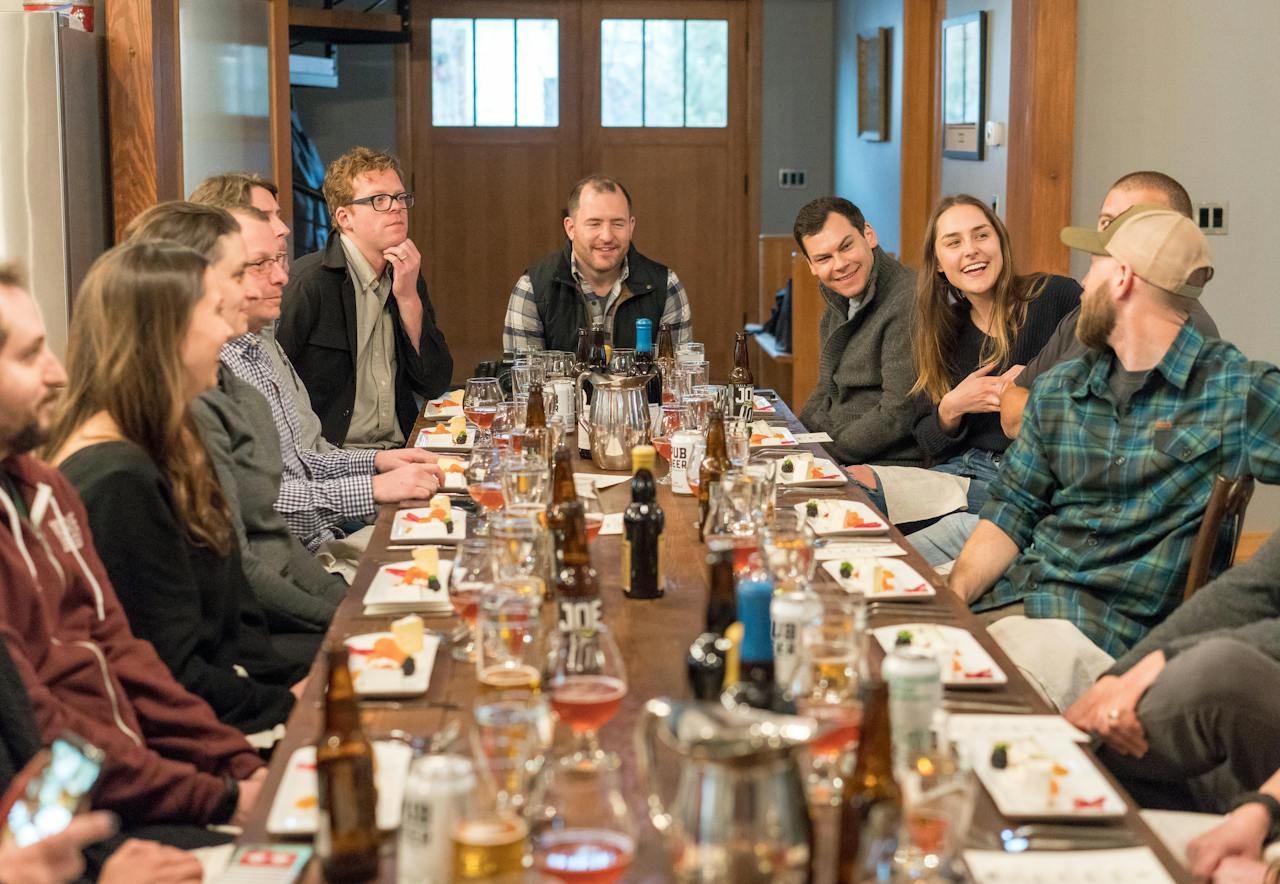Smart Strategies for Setting Restaurant Operating Hours
By Anttoni Taimela · 31. January 2024
Determining the right restaurant operating hours can make or break your business.
This guide dives straight into practical strategies to identify your ideal business times⏰, ensuring your restaurant thrives in its unique context.
Key Takeaways
- Hit the sweet spot by tailoring restaurant hours to peak meal times, analyzing foot traffic, and piggybacking on local events to boost the belly count.
- Avoid the staffing scramble by managing shift rotations like a maestro, recruiting for rush hours, and dancing smoothly with unexpected staff fluctuations.
- Stay in sync with the seasons and legal beats – tweak your hours to match tourist tides, weather whims, and those pesky licensing laws.
Determining Your Restaurant’s Prime Hours
 woman eating in a restaurant
woman eating in a restaurant
Before you can set your restaurant’s hours, you need to determine your prime hours.
Think of it as finding the golden time slot in your day when your restaurant is the belle of the ball, with the most customers flocking in for your delicious dishes.
This involves a scrumptious trio of strategies: identifying peak meal service times, analyzing foot traffic trends, and leveraging local events and attractions.
Identifying Peak Meal Service Times
Ever noticed how some restaurant hours are as chaotic as a food fight, while others are as calm as a quiet corner table?
Those are your peak meal service times – the lunch rush hours when your customers are most likely to be ravenous for your menu specials.
Identifying these times is critical for optimizing your restaurant’s hours and cutting hours during less busy periods.
Here are some steps to help you do that:
- Observe the ebb and flow of your customers.
- Keep an eye on the average waiting times for meals.
- Use restaurant software and analytics tools to glean data on customer behavior.
By following these steps, you can better understand your peak meal service times and make informed decisions about your restaurant’s hours.
Analyzing Foot Traffic Trends
Now, let’s move to the streets. Or more precisely, let’s talk foot traffic. It’s like a pulse, revealing the heartbeats of your potential customers passing by your restaurant.
By analyzing foot traffic trends, you can determine the best hours to keep your doors open and your kitchen buzzing.
There are various tools to help you with this research, including foot traffic tracking software and people counting systems.
These insights will allow you to fine-tune staffing and services, making sure your restaurant is always ready to welcome customers.
Leveraging Local Events and Attractions
Now, let’s talk about serving the neighborhood. Local events and attractions can attract potential customers to your area and influence your restaurant’s peak hours.
By aligning your operating hours with these local happenings and offering special promotions, you can increase your visibility and sales during these peak periods.
The goal is to capitalize on local excitement and make sure your restaurant is part of the experience, attracting customers to nearby restaurants as well.
Crafting a Schedule That Suits Your Staffing Capabilities
After determining your prime hours, it’s time to juggle the next challenge; Staffing.
Just as a kitchen needs the right ingredients, a restaurant needs to hire the right number of staff👔 at the right time.
This requires a delicate balance of managing shift rotations, hiring strategically for peak times, and adapting to staffing fluctuations.
Seems like a balancing act? Fear not, we’re here to guide you. Let’s dissect it!
Managing Shift Rotations Efficiently
Managing shift rotations is like conducting a symphony of servers, chefs, and bartenders.
It involves balancing open shifts, cross-training staff, and ensuring clear communication for any schedule changes.
The goal? To keep your restaurant humming along smoothly and your customers serviced efficiently, even during the busiest of times.
Hiring Strategies for Peak Times
Next week, let’s talk about hiring for peak times. It’s all about matching your staff strength with customer demand, ensuring you have enough hands on deck when the restaurant is buzzing.
Strategic hiring not only helps maintain service quality but also prevents existing staff from burning out.
Consider it as constructing a sturdy engine that can endure the night and busiest hours without faltering.
Adapting to Staffing Fluctuations
Finally, let’s talk about the unpredictable. Staffing fluctuations can be as erratic as a dropped tray of dishes.
But with flexible scheduling and clear communication, you can navigate these changes without a hitch.
The aim is to stay flexible, adapt to unforeseen staffing shortages or abrupt customer surges, and keep your restaurant running smoothly.
Aligning With Legal and Community Norms
Now that we’ve got the timing and staffing down, it’s time to consider the rules of the game.
Every restaurant operates within a framework of legal and community norms.
From licensing and curfew laws to neighborhood culture, these norms can significantly influence your restaurant’s operating hours.
Let’s explore how to effectively balance these aspects.
Complying With Licensing and Curfew Laws
Running a restaurant isn’t just about satisfying taste buds; it’s also about complying with laws.
Licensing laws⚖️ can dictate when you can serve alcohol, and curfew laws can determine when you must close your doors. Ignoring these laws can lead to fines, and business disruptions.
Therefore, understanding these limitations early and integrating them into your limited hours and operating hours is crucial.
Balancing Hours With Neighborhood Culture
Beyond laws factors, it’s the neighborhood culture that can shape your restaurant’s vibe and operating hours.
Understanding and adapting to local dining habits and preferences can help you set hours that resonate with your community, fostering local support and patronage.
The goal🎯 is to be a good neighbor while also running a thriving business.
Seasonal Adjustments to Operating Hours
 group restaurant hangout
group restaurant hangout
As seasons change, so do the city and dining habits. The bustling summer tourist season can lead to an influx of customers, requiring extended hours, while the quiet winter months might allow for shorter days.
In this section, we’ll cover how to adjust your restaurant’s seasonal hours, taking into account the effects of tourism and weather-related changes on operating hours.
Evaluating the Impact of Tourism
Tourism can significantly impact your restaurant’s hours of operation, affecting its operating hours.
An influx of tourists can increase demand, requiring extended hours.
Conversely, a decline in tourist activity might allow for shorter hours.
Understanding and anticipating tourism trends allows you to modify your operating hours to maximize profits.
Responding to Weather-Related Changes
Just as the seasons can influence tourists’ plans, they can also affect your local customers’ casual dining habits.
Extreme weather conditions can deter customers from dining out, while pleasant weather can see an increase in demand.
Staying responsive to weather-related changes enables you to adjust your operating hours in line with customer behavior for maximum profit.
Competitive Insight: Learning From Others
As the old saying goes, keep your friends close and your competitors closer.
By studying your competitors, you can gain valuable insights about effective operating hours.
In this section, we’ll cover how to benchmark against local competitors and grasp industry standards to assist in setting your restaurant’s hours.
Benchmarking Against Local Competitors
Benchmarking involves analyzing your competitors to understand their strategies and results.
By benchmarking your restaurant’s operating hours against local competitors, for example, you can identify potential improvements and opportunities for your business.
Understanding Industry Standards
Apart from your local competition, understanding the wider industry standards for restaurant operating hours is crucial.
This knowledge can help you ensure that your business remains competitive and attractive to customers.
Fine-Tuning for Customer Convenience
At the end of the day, your customers are the heart of your restaurant.
Ensuring their convenience can go a long way in building customer loyalty and maximizing profits.
Here, we’ll delve into how to adjust your restaurant’s operating hours for customer convenience, including offering flexible dining options and prioritizing customer feedback.
Offering Flexible Dining Options
Flexible dining options can significantly enhance customer convenience.
By accommodating various customer preferences and schedules, many independent restaurants here, including those who prefer deli food, can ensure a satisfying dining experience for all their customers.
With our friendly service, we strive to meet the diverse needs of our patrons.
Prioritizing Customer Feedback
Your customers can provide valuable insights to help improve your restaurant’s operating hours.
By collecting and prioritizing customer feedback, you can make informed decisions that enhance customer convenience and satisfaction.
Marketing Your Operating Hours Effectively
Having set your restaurant’s hours, it’s time to spread the word!
This section will cover effective marketing strategies for your restaurant’s operating hours, including social media promotion of special hours and the use of signage and local advertising.
Promoting Special Hours on Social Media
Social media can be a powerful tool for promoting your restaurant’s special hours.
By creating engaging content and using different platforms, you can reach a wide audience and attract more customers during specific times.
Utilizing Signage and Local Advertising
Signage and local advertising can effectively inform potential customers of your restaurant’s operating hours.
By creating attractive signage and implementing effective local advertising strategies, you can increase your restaurant’s visibility and attract more customers.
Summary
As we wrap up this culinary journey into the art of setting restaurant operating hours, let us revisit the key takeaways.
From determining prime hours to crafting schedules that suit staffing capabilities, ensuring compliance with legal norms, adapting to seasonal changes, learning from competitors, and fine-tuning for customer convenience, we’ve covered the whole gamut of strategies to maximize profits by optimizing operating hours.
Remember, the key to success is staying flexible, responsive, and customer-centric.
Here’s to running a successful restaurant that keeps both the cash register and the customers happy!
Frequently Asked Questions
What does it mean to get an 8 top?
Getting an 8 top means having a table that can seat eight diners. So, it’s time to round up your squad!
How can I determine my restaurant’s prime hours?
To determine your restaurant’s prime hours, keep an eye on peak meal times, analyze foot traffic, and take advantage of local events and attractions. Happy hustling!
How can I manage shift rotations efficiently?
To manage shift rotations efficiently, offer open shifts for employees to choose from, cross-train staff for flexibility, and maintain clear communication for schedule changes. Happy scheduling!
How can I comply with licensing and curfew laws?
To comply with licensing and curfew laws, understand the restrictions, adjust your operating hours accordingly, and keep an eye on any legal updates. Stay savvy, and you’ll stay compliant.
How can I adjust my restaurant’s operating hours for seasonal changes?
Evaluate the impact of tourism and respond to weather-related changes to adjust your restaurant establishment’s operating hours for seasonal variations. Stay flexible and keep your profits flowing!

